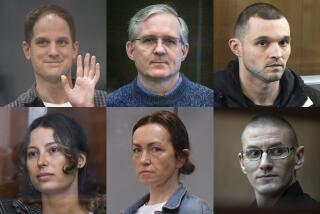U.S. Gets New Leads in Russia Search for MIAs : Military: Task force officials in Moscow hear of captured F-86s and prisoner interrogations during the Korean War.
- Share via
MOSCOW — American officials reported new leads Wednesday in their effort to account for U.S. servicemen who vanished during the Korean War more than 40 years ago.
Malcolm C. Toon, co-chairman of a joint U.S.-Russian task force on POWs and MIAs, said the Russians acknowledged that Soviet pilots then were trained to try to bring down U.S. F-86 fighter jets over Korea safely so they could be examined, and that two such aircraft were transported to Moscow “in flight-worthy condition.”
Speaking to reporters after the task force’s seventh meeting, Toon, a former U.S. ambassador to Moscow, said the group also learned that some Americans captured in Korea were interrogated by the Soviets in Korea and China.
The task force, formed last year, is part of a U.S. effort to trace thousands of servicemen who disappeared during World War II, the Korean War and the war in Vietnam. American officials say they doubt any of the missing are being held alive but hope that the Russians will turn over remains, artifacts or information about them.
Moscow’s disclosure of the Soviet intelligence program to bring down and study the F-86s, the most advanced U.S. warplanes of the Korean War, raised the likelihood that some of their pilots were taken alive and interrogated and may be accounted for in Russian archives.
The American side of the task force came to Moscow with a list of 13 missing F-86 pilots who they believe were brought to the Soviet Union during the war. But Gen. Dmitri Volkogonov, the Russian co-chairman, told the news conference that “extensive work” in the files uncovered “neither documents nor testimony nor facts to confirm this hypothesis.”
“We have no proof yet that U.S. pilots were transferred to the Soviet Union,” Toon added, “but we have assembled a good deal of information that compels us to continue to search in that direction. The Russian side is firmly committed to continue investigation on this question.”
Rep. Sam Johnson (R-Tex.), a task force member who flew F-86s on 62 combat missions in Korea, said the Russians promised to find tail numbers of the two jets brought here so the Pentagon can identify the pilots.
Johnson said he is hopeful that the investigation will bear fruit. “Every time you look in the records here you always find something new, you always uncover another lead,” he said.
An earlier clue that U.S. prisoners were sent from Korea to the Soviet Union came to light in August when a retired Soviet colonel leafing through photos of American POWs identified Marine Sgt. Philip Mandra, a Korean War MIA from New York, as the foreigner he saw at a KGB prison in Russia’s Far East in 1962.
Russian and American members of the task force questioned the 74-year-old witness, Vladimir Malinin, and drew different conclusions.
“I have very strong doubts,” Volkogonov said. “Malinin maintains he saw the man 30 years ago for a couple of minutes from a second-floor window. You have to have a phenomenal visual memory to remember a person you saw only once 30 years ago.”
Toon said, “I found the colonel to be highly articulate and, I think, credible.” He said the Russians agreed to allow Mandra’s sister and brother, who are now in Moscow, to question the KGB prison’s former director.
The task force this week obtained excerpts of a seven-volume Russian intelligence study of the Vietnam War that may shed light on the fate of American MIAs there. It also received the class ring of Capt. John Robertson Dunham, a U.S. Air Force pilot whose spy plane was shot down over Russia in 1952--one of 10 such Cold War incidents that the task force is investigating.
Vasily Saiko, 64, the Russian sailor who found the pilot’s body and took the ring, handed over the ring after reading a newspaper advertisement placed by the task force for information about American MIAs.
“If more citizens like Mr. Saiko step forward, we will continue to make good progress,” Toon said.
American interest in its missing servicemen has prompted the Russians to press their own search for Soviet citizens who disappeared on Cold War battlefields in places such as Ethiopia, Afghanistan and Somalia.
Volkogonov said “thousands” of servicemen are being sought, along with civilians like Yuri Alexandrov, a young physicist who was researching the effects of nuclear warfare and vanished during a scientific conference in Madrid in the mid-1980s.
More to Read
Sign up for Essential California
The most important California stories and recommendations in your inbox every morning.
You may occasionally receive promotional content from the Los Angeles Times.













